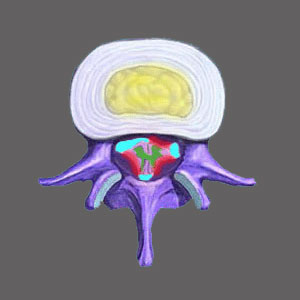
There are many potential causes of spinal stenosis and every case may have different causative and contributory factors involved in the condition. In some patients, the causes of central canal stenosis may be easily treated, while in others, the source conditions may be very difficult to resolve. In many patients, although stenosis may be present, the condition may be coincidental to any pain experienced, particularly in mild to moderate forms of spinal canal stenosis. Remember, just because stenosis exists does not mean it is the definitive causation for back pain or neck pain.
This resource section details all the possible sources of a narrowed central spinal canal.
Causes of Spinal Stenosis Topics
Here are some of the various possible causes of central canal stenosis and neuroforaminal stenosis:
Ligamentum flavum hypertrophy can cause stenosis in the posterior of the central canal and may very rarely actually capture and compress a nerve root.
Posterior longitudinal ligament ossification is another type of soft tissue problem that can close off the anterior of the central spinal canal.
Spinal stenosis from scoliosis can cause central or foraminal narrowing due to this common and sometimes problematic side to side spinal curvature.
Spinal stenosis from arthritis is the most common type of permanent central and foraminal stenosis. Arthritis is normal to experience as we age and arthritic change in the spine is expected and universal.
Spinal stenosis osteophytes can cause focal locations of stenosis anywhere in the spine. Osteophytes, also called bone spurs, are part of the arthritic processes.
A congenitally narrowed spinal canal may create a stenosis condition even when all is perfect in the spine. Most of these issues are never concerning or painful unto themselves, but may increase the chances for symptomatic stenosis when other spinal abnormalities exist in the same vertebral levels.
Spinal stenosis from spondylolisthesis is an unfortunate result of advanced vertebral misalignment. Anterolisthesis and retrolisthesis are both potentially causative conditions.
Spinal stenosis from vertebral fracture is very typical in older people. Injuries and compression fracture can send bits of bone into the spinal canal, causing serious central stenosis in some cases.
Spinal stenosis from degenerative disc disease is a contributory factor to central and foraminal stenosis when the vertebrae become very close together. However, symptomatic stenosis from DDD is rare, unless there are other contributing factors.
Spinal stenosis from a herniated disc is a common source of temporary stenosis. This soft tissue based stenosis is usually easier to treat conservatively than bone-induced canal narrowing, although recurrences are far more common after surgical intervention.
Spinal stenosis from spinal curvature may result from extreme abnormal front to back curvatures, such as hyperlordosis and hyperkyphosis.
Spinal stenosis back injury can damage the central or foraminal canal spaces enacting stenosis. Car accidents can cause spinal stenosis, as can many other traumas.
Our program can help to mitigate pain, regardless of its cause. It is no surprise that the Cure Back Pain Forever Program was named a top treatment option for chronic pain by doctors and healthcare organizations worldwide.
Related Conditions to Spinal Stenosis
Here are some of the other issues which can occur due to spinal stenosis or have some relationship to the stenosis condition:
Spinal stenosis and osteoporosis are related since loss of bone density is a leading contributor to spinal degeneration and compression fractures. Many elder people diagnosed with osteopenia and osteoporosis will also have spinal stenosis.
Spinal stenosis and fibromyalgia may exist in the same patient or may be mistaken for one another. Learn more about the relationship between FMS and central canal stenosis.
Causes of Spinal Stenosis Advisory
No two cases of stenosis are exactly alike. Many are caused by identical structural conditions, but some are truly individual and case-specific in their origin. However, even when the underlying cause of canal narrowing is the same, the symptoms of spinal stenosis will likely be very different from one patient to another. This is the cruel nature of the condition and one of the main factors which makes diagnosis and treatment so difficult.
Remember, it is crucial to know that many mild to moderate cases of central canal or foraminal stenosis may surely exist, but are not the source of pain. In these misdiagnosed cases, there is often another undiscovered structural condition responsible or a nonstructural regional process, such as ischemia.
Spinal Stenosis > Causes of Spinal Stenosis





